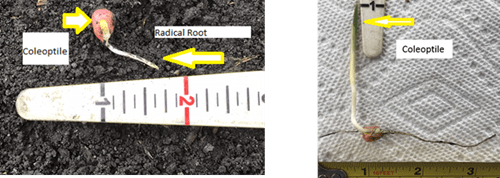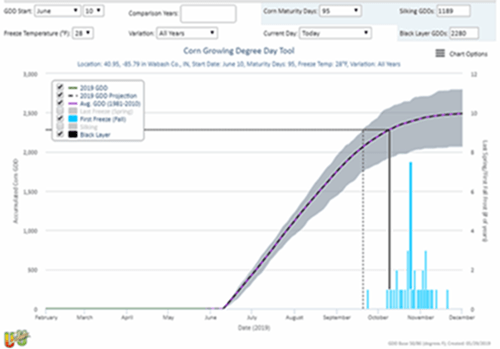Agronomy Update: Planting Progress
BY DAIRYLAND SEED AGRONOMY TEAM
Corn Planting Progress
Corn planting progress is to say the least “variable” with some areas yet to put a kernel in the ground and others with a few acres in.
On fields that did get planted, we are starting to see germination, and emergence taking place. The photo on the left shows the Radical Root emerged, this starts at 30-40 Growing Degree Units (GDU’s). This photo also shows the Coleoptile starting to emerge from the seed, which takes place at 50-60 GDU’s. The photo on the right shows a Coleoptile that is just starting to emerge from the soil, with about 1” showing above the soil line.
 |
| Weather conditions and genetic families have influence on when plants emerge from the soil, with most taking 100-150 GDU’s to do so. |
The current weather conditions as well as less than ideal planting conditions in some instances may be hampering corn emergence. The table below shows the approximate GDU’s needed for each growth stage, up to V1. If you have corn that has been planted and has accumulated or is approaching 100 GDU’s since planting, take a moment to see how it is emerging.
Plants that are slow emerging may need additional help via a drag or rotary hoe. If you have fields that are slow emerging contact your local Dairyland Seed District Manager or Regional Agronomist to discuss this or other Agronomic issues.
| Plant/Leaf Stage | Growth Stage | GDUs |
| Germination | 10 to 20 | |
| Radicle Root Emergence | 30 to 40 | |
| Coleoptile Emergence Seed | 50 to 60 | |
| Seminal Root Emergence | 60 to 70 | |
| Coleoptile Emergence Soil | VE | 100 to 150 |
| First collar on emerged leaf | V1 | 150 to 190 |
Use Information Available to Investigate Options
It is our job as agronomists and seedsmen to use data to investigate the wealth of information in this technological age. Historical evidence can assist growers in making decisions that can be valuable in years like this one if used judiciously. Many schools of thought concerning late or very late corn planting and GDU accumulation for the remainder of the season exist and are hotly debated in most instances. See the end of this article for several websites providing tools, webinars, and information that can assist you in helping make a plan that could benefit your operation.
Historical weather data and GDU potential for late planting can be found by using https://hprcc.unl.edu/gdd.php
Generate a sample similar to the example shown below of a hybrid planted in Wabash County, Indiana, by plugging in your county and approximate RM you wish to plant (95 RM in this case) along with planting date estimations on June 10’s probability of achieving black layer based on 30 years of historical weather data for this geography (top figure).

The following example below uses the same parameters only for Washington Co., Wisconsin. While not the exact answer this can assist in making more informed decisions in difficult years. Study, ask, learn, and attempt….in the end it’s all any of us can do to make the best choices possible in difficult seasons.

http://www.kingcorn.org/news/timeless/HybridMaturityDelayedPlant.html
https://www.youtube.com/watch?v=OYLbjfCtk8g&feature=youtu.be
http://corn.agronomy.wisc.edu/Pubs/UWEX/A3353.pdf
https://blog-crop-news.extension.umn.edu/2019/05/prevented-plant-considerations-for-corn.html
Asiatic Garden Beetle
For those of you with corn planted on sandy and sandy loam soils, especially in the east (Indiana, Michigan, and Ohio):
We are seeing higher than expected levels of Asiatic garden beetle larvae in the soil. This larva looks like a typical white grub, only smaller. It is more aggressive than most white grubs when disturbed – it will crawl rapidly and will try to bite you if you hold it in your hand.
Larvae feed on seedling roots and eventually feed on the mesocotyl (underground stem), often causing seedling death. If you see seedlings that are not growing well or are dying, dig up roots and examine them for feeding. There is no rescue treatment and replant will be necessary if plant death is severe and widespread enough in the field.
Call if you have questions.
Alfalfa Harvest
If first crop alfalfa is still on the horizon, remember that it is typically 40 percent of your annual yield and is often the highest quality crop for the year. Be sure to prioritize alfalfa harvest over any remaining planting activity of annual crops. While this is certainly a “make hay when the sun shines” kind of spring, here are some thoughts to consider with your operation:
- As alfalfa reaches bud/early flower stages it can be growing 1 inch per day, which is generally considered to add 100 pounds of dry matter per acre per day in a good stand.
- You may need tonnage, but don’t be caught off guard by diminishing quality components as the crop matures. The good news: Dairyland Seed’s hybrid alfalfas have demonstrated high performance in short and long interval cutting schedules.
- Wheel traffic soon after cutting will reduce subsequent yield by 5 to 10 percent, while traffic 5 to 7 days after cutting can reduce future yields by 15 to 25 percent. Traffic on wet soil can damage crowns.
Let the sun shine!
 |
 |
 |
 |
 |
| Brian Weller Western Region 507.456.3034 |
Dan Ritter Central Region 219.863.0583 |
Branden Furseth Northern Region 608.513.4265 |
Rod King Eastern Region 574.596.6721 |
Terry Jones Eastern Region 419.630.3115 |
